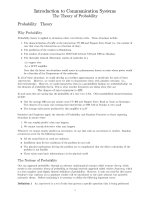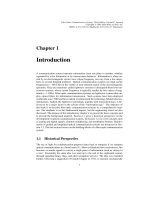Tài liệu Fibre optic communication systems P1 doc
Bạn đang xem bản rút gọn của tài liệu. Xem và tải ngay bản đầy đủ của tài liệu tại đây (323.2 KB, 22 trang )
Chapter 1
Introduction
A communication system transmits information from one place to another, whether
separated by a few kilometers or by transoceanic distances. Information is often car-
ried by an electromagnetic carrier wave whose frequency can vary from a few mega-
hertz to several hundred terahertz. Optical communication systems use high carrier
frequencies (∼100 THz) in the visible or near-infrared region of the electromagnetic
spectrum. They are sometimes called lightwave systems to distinguish them from mi-
crowave systems, whose carrier frequency is typically smaller by five orders of mag-
nitude (∼1 GHz). Fiber-optic communication systems are lightwave systems that em-
ploy optical fibers for information transmission. Such systems have been deployed
worldwide since 1980 and have indeed revolutionized the technology behind telecom-
munications. Indeed, the lightwave technology, together with microelectronics, is be-
lieved to be a major factor in the advent of the “information age.” The objective of
this book is to describe fiber-optic communication systems in a comprehensive man-
ner. The emphasis is on the fundamental aspects, but the engineering issues are also
discussed. The purpose of this introductory chapter is to present the basic concepts and
to provide the background material. Section 1.1 gives a historical perspective on the
development of optical communication systems. In Section 1.2 we coverconcepts such
as analog and digital signals, channel multiplexing, and modulation formats. Relative
merits of guided and unguided optical communication systems are discussed in Sec-
tion 1.3. The last section focuses on the building blocks of a fiber-optic communication
system.
1.1 Historical Perspective
The use of light for communication purposes dates back to antiquity if we interpret
optical communications in a broad sense [1]. Most civilizations have used mirrors, fire
beacons, or smoke signals to convey a single piece of information (such as victory in
a war). Essentially the same idea was used up to the end of the eighteenth century
through signaling lamps, flags, and other semaphore devices. The idea was extended
further, following a suggestion of Claude Chappe in 1792, to transmit mechanically
1
Fiber-Optic Communications Systems, Third Edition. Govind P. Agrawal
Copyright
2002 John Wiley & Sons, Inc.
ISBNs: 0-471-21571-6 (Hardback); 0-471-22114-7 (Electronic)
2
CHAPTER 1. INTRODUCTION
Figure 1.1: Schematic illustration of the optical telegraph and its inventor Claude Chappe. (After
Ref. [2];
c
1944 American Association for the Advancement of Science; reprinted with permis-
sion.)
coded messages over long distances (∼100 km) by the use of intermediate relay sta-
tions [2], acting as regenerators or repeaters in the modern-day language. Figure 1.1
shows the basic idea schematically. The first such “optical telegraph” was put in service
between Paris and Lille (two French cities about 200 km apart) in July 1794. By 1830,
the network had expanded throughout Europe [1]. The role of light in such systems
was simply to make the coded signals visible so that they could be intercepted by the
relay stations. The opto-mechanical communication systems of the nineteenth century
were inherently slow. In modern-day terminology, the effective bit rate of such systems
was less than 1 bit per second (B < 1 b/s).
1.1.1 Need for Fiber-Optic Communications
The advent of telegraphy in the 1830s replaced the use of light by electricity and began
the era of electrical communications [3]. The bit rate B could be increased to ∼ 10 b/s
by the use of new coding techniques, such as the Morse code. The use of intermediate
relay stations allowed communication over long distances (∼ 1000 km). Indeed, the
first successful transatlantic telegraph cable went into operation in 1866. Telegraphy
used essentially a digital scheme through two electrical pulses of different durations
(dots and dashes of the Morse code). The invention of the telephone in 1876 brought
a major change inasmuch as electric signals were transmitted in analog form through a
continuously varying electric current [4]. Analog electrical techniques were to domi-
nate communication systems for a century or so.
The development of worldwide telephone networks during the twentieth century
led to many advances in the design of electrical communication systems. The use
of coaxial cables in place of wire pairs increased system capacity considerably. The
first coaxial-cable system, put into service in 1940, was a 3-MHz system capable of
transmitting 300 voice channels or a single television channel. The bandwidth of such
systems is limited by the frequency-dependent cable losses, which increase rapidly for
frequencies beyond 10 MHz. This limitation led to the development of microwave
communication systems in which an electromagnetic carrier wave with frequencies in
Publisher's Note:
Permission to reproduce this image
online was not granted by the
copyright holder. Readers are kindly
asked to refer to the printed version
of this chapter.
1.1. HISTORICAL PERSPECTIVE
3
Figure 1.2: Increase in bit rate–distance product BL during the period 1850–2000. The emer-
gence of a new technology is marked by a solid circle.
the range of 1–10 GHz is used to transmit the signal by using suitable modulation
techniques.
The first microwave system operating at the carrier frequency of 4 GHz was put
into service in 1948. Since then, both coaxial and microwave systems have evolved
considerably and are able to operate at bit rates ∼100 Mb/s. The most advanced coax-
ial system was put into service in 1975 and operated at a bit rate of 274 Mb/s. A severe
drawback of such high-speed coaxial systems is their small repeater spacing (∼1 km),
which makes the system relatively expensive to operate. Microwave communication
systems generally allow for a larger repeater spacing, but their bit rate is also limited
by the carrier frequency of such waves. A commonly used figure of merit for commu-
nication systems is the bit rate–distance product, BL, where B is the bit rate and L is
the repeater spacing. Figure 1.2 shows how the BL product has increased through tech-
nological advances during the last century and a half. Communication systems with
BL ∼ 100 (Mb/s)-km were available by 1970 and were limited to such values because
of fundamental limitations.
It was realized during the second half of the twentieth century that an increase
of several orders of magnitude in the BL product would be possible if optical waves
were used as the carrier. However, neither a coherent optical source nor a suitable
transmission medium was available during the 1950s. The invention of the laser and
its demonstration in 1960 solved the first problem [5]. Attention was then focused
on finding ways for using laser light for optical communications. Many ideas were
4
CHAPTER 1. INTRODUCTION
1980 1985 1990 1995 2000 2005
Year
0.01
0.1
1
10
100
1000
10000
Bit Rate (Gb/s)
Research
Commercial
Figure 1.3: Increase in the capacity of lightwave systems realized after 1980. Commercial
systems (circles) follow research demonstrations (squares) with a few-year lag. The change in
the slope after 1992 is due to the advent of WDM technology.
advancedduring the 1960s [6], the most noteworthy being the idea of light confinement
using a sequence of gas lenses [7].
It was suggested in 1966 that optical fibers might be the best choice [8], as they
are capable of guiding the light in a manner similar to the guiding of electrons in cop-
per wires. The main problem was the high losses of optical fibers—fibers available
during the 1960s had losses in excess of 1000 dB/km. A breakthrough occurred in
1970 when fiber losses could be reduced to below 20 dB/km in the wavelength region
near 1
µ
m [9]. At about the same time, GaAs semiconductor lasers, operating contin-
uously at room temperature, were demonstrated [10]. The simultaneous availability of
compact optical sources and a low-loss optical fibers led to a worldwide effort for de-
veloping fiber-optic communication systems [11]. Figure 1.3 shows the increase in the
capacity of lightwave systems realized after 1980 through several generations of devel-
opment. As seen there, the commercial deployment of lightwave systems followed the
research and development phase closely. The progress has indeed been rapid as evi-
dent from an increase in the bit rate by a factor of 100,000 over a period of less than 25
years. Transmission distances have also increased from 10 to 10,000 km over the same
time period. As a result, the bit rate–distance product of modern lightwave systems can
exceed by a factor of 10
7
compared with the first-generation lightwave systems.
1.1.2 Evolution of Lightwave Systems
The research phase of fiber-optic communication systems started around 1975. The
enormous progress realized over the 25-year period extending from 1975 to 2000 can
be grouped into several distinct generations. Figure 1.4 shows the increase in the BL
product overthis time period as quantified throughvarious laboratoryexperiments [12].
The straight line corresponds to a doubling of the BL product every year. In every
1.1. HISTORICAL PERSPECTIVE
5
Figure 1.4: Increase in the BL product over the period 1975 to 1980 through several generations
of lightwave systems. Different symbols are used for successive generations. (After Ref. [12];
c
2000 IEEE; reprinted with permission.)
generation, BL increases initially but then begins to saturate as the technology matures.
Each new generation brings a fundamental change that helps to improve the system
performance further.
The first generation of lightwave systems operated near 0.8
µ
m and used GaAs
semiconductorlasers. After several field trials during the period 1977–79, such systems
became available commercially in 1980 [13]. They operated at a bit rate of 45 Mb/s
and allowed repeater spacings of up to 10 km. The larger repeater spacing compared
with 1-km spacing of coaxial systems was an important motivation for system design-
ers because it decreased the installation and maintenance costs associated with each
repeater.
It was clear during the 1970s that the repeater spacing could be increased consid-
erably by operating the lightwave system in the wavelength region near 1.3
µ
m, where
fiber loss is below 1 dB/km. Furthermore, optical fibers exhibit minimum dispersion in
this wavelength region. This realization led to a worldwide effort for the development
of InGaAsP semiconductor lasers and detectors operating near 1.3
µ
m. The second
generation of fiber-optic communication systems became available in the early 1980s,
but the bit rate of early systems was limited to below 100 Mb/s because of dispersion in
multimode fibers [14]. This limitation was overcome by the use of single-mode fibers.
A laboratory experiment in 1981 demonstrated transmission at 2 Gb/s over 44 km of
single-mode fiber [15]. The introduction of commercial systems soon followed. By
1987, second-generation lightwave systems, operating at bit rates of up to 1.7 Gb/s
with a repeater spacing of about 50 km, were commercially available.
The repeater spacing of the second-generation lightwave systems was limited by
the fiber losses at the operating wavelength of 1.3
µ
m (typically 0.5 dB/km). Losses
6
CHAPTER 1. INTRODUCTION
of silica fibers become minimum near 1.55
µ
m. Indeed, a 0.2-dB/km loss was real-
ized in 1979 in this spectral region [16]. However, the introduction of third-generation
lightwave systems operating at 1.55
µ
m was considerably delayed by a large fiber
dispersion near 1.55
µ
m. Conventional InGaAsP semiconductor lasers could not be
used because of pulse spreading occurring as a result of simultaneous oscillation of
several longitudinal modes. The dispersion problem can be overcome either by using
dispersion-shifted fibers designed to have minimum dispersion near 1.55
µ
m or by lim-
iting the laser spectrum to a single longitudinal mode. Both approaches were followed
during the 1980s. By 1985, laboratory experiments indicated the possibility of trans-
mitting information at bit rates of up to 4 Gb/s over distances in excess of 100 km [17].
Third-generation lightwave systems operating at 2.5 Gb/s became available commer-
cially in 1990. Such systems are capable of operating at a bit rate of up to 10 Gb/s [18].
The best performance is achieved using dispersion-shifted fibers in combination with
lasers oscillating in a single longitudinal mode.
A drawback of third-generation 1.55-
µ
m systems is that the signal is regenerated
periodically by using electronic repeaters spaced apart typically by 60–70 km. The
repeater spacing can be increased by making use of a homodyne or heterodyne detec-
tion scheme because its use improves receiver sensitivity. Such systems are referred
to as coherent lightwave systems. Coherent systems were under development world-
wide during the 1980s, and their potential benefits were demonstrated in many system
experiments [19]. However, commercial introduction of such systems was postponed
with the advent of fiber amplifiers in 1989.
The fourth generation of lightwave systems makes use of optical amplification for
increasing the repeater spacing and of wavelength-division multiplexing (WDM) for
increasing the bit rate. As evident from different slopes in Fig. 1.3 before and after
1992, the advent of the WDM technique started a revolution that resulted in doubling
of the system capacity every 6 months or so and led to lightwave systems operating at
a bit rate of 10 Tb/s by 2001. In most WDM systems, fiber losses are compensated
periodically using erbium-doped fiber amplifiers spaced 60–80 km apart. Such ampli-
fiers were developed after 1985 and became available commercially by 1990. A 1991
experiment showed the possibility of data transmission over 21,000 km at 2.5 Gb/s,
and over 14,300 km at 5 Gb/s, using a recirculating-loop configuration [20]. This per-
formance indicated that an amplifier-based, all-optical, submarine transmission system
was feasible for intercontinental communication. By 1996, not only transmission over
11,300 km at a bit rate of 5 Gb/s had been demonstrated by using actual submarine
cables [21], but commercial transatlantic and transpacific cable systems also became
available. Since then, a large number of submarine lightwave systems have been de-
ployed worldwide.
Figure 1.5 shows the international network of submarine systems around 2000 [22].
The 27,000-kmfiber-optic link around the globe (knownas FLAG) became operational
in 1998, linking many Asian and European countries [23]. Another major lightwave
system, known as Africa One was operating by 2000; it circles the African continent
and covers a total transmission distance of about 35,000 km [24]. Several WDM sys-
tems were deployed across the Atlantic and Pacific oceans during 1998–2001 in re-
sponse to the Internet-induced increase in the data traffic; they have increased the total
capacity by orders of magnitudes. A truly global network covering 250,000 km with a
1.1. HISTORICAL PERSPECTIVE
7
Figure 1.5: International undersea network of fiber-optic communication systems around 2000.
(After Ref. [22];
c
2000 Academic; reprinted with permission.)
capacity of 2.56 Tb/s (64 WDM channels at 10 Gb/s over 4 fiber pairs) is scheduled to
be operational in 2002 [25]. Clearly, the fourth-generation systems have revolutionized
the whole field of fiber-optic communications.
The current emphasis of WDM lightwave systems is on increasing the system ca-
pacity by transmitting more and more channels through the WDM technique. With
increasing WDM signal bandwidth, it is often not possible to amplify all channels
using a single amplifier. As a result, new kinds of amplification schemes are being
explored for covering the spectral region extending from 1.45 to 1.62
µ
m. This ap-
proach led in 2000 to a 3.28-Tb/s experiment in which 82 channels, each operating at
40 Gb/s, were transmitted over 3000 km, resulting in a BL product of almost 10,000
(Tb/s)-km. Within a year, the system capacity could be increased to nearly 11 Tb/s
(273 WDM channels, each operating at 40 Gb/s) but the transmission distance was
limited to 117 km [26]. In another record experiment, 300 channels, each operating
at 11.6 Gb/s, were transmitted over 7380 km, resulting in a BL product of more than
25,000 (Tb/s)-km [27]. Commercial terrestrial systems with the capacity of 1.6 Tb/s
were available by the end of 2000, and the plans were underway to extend the capacity
toward 6.4 Tb/s. Given that the first-generation systems had a capacity of 45 Mb/s in
1980, it is remarkable that the capacity has jumped by a factor of more than 10,000
over a period of 20 years.
The fifth generation of fiber-optic communication systems is concerned with ex-
tending the wavelength range over which a WDM system can operate simultaneously.
The conventional wavelength window, known as the C band, covers the wavelength
range 1.53–1.57
µ
m. It is being extended on both the long- and short-wavelengthsides,
resulting in the L and S bands, respectively. The Raman amplification technique can be
used for signals in all three wavelength bands. Moreover, a new kind of fiber, known
as the dry fiber has been developed with the property that fiber losses are small over
the entire wavelength region extending from 1.30 to 1.65
µ
m [28]. Availability of such
fibers and new amplification schemes may lead to lightwave systems with thousands of
WDM channels.
The fifth-generation systems also attempt to increase the bit rate of each channel
8
CHAPTER 1. INTRODUCTION
within the WDM signal. Starting in 2000, many experimentsused channels operatingat
40 Gb/s; migration toward 160 Gb/s is also likely in the future. Such systems require an
extremely careful management of fiber dispersion. An interesting approach is based on
the concept of optical solitons—pulses that preserve their shape during propagation in
a lossless fiber by counteracting the effect of dispersion through the fiber nonlinearity.
Although the basic idea was proposed [29] as early as 1973, it was only in 1988 that
a laboratory experiment demonstrated the feasibility of data transmission over 4000
km by compensating the fiber loss through Raman amplification [30]. Erbium-doped
fiber amplifiers were used for soliton amplification starting in 1989. Since then, many
system experiments have demonstratedthe eventual potential of soliton communication
systems. By 1994, solitons were transmitted over 35,000 km at 10 Gb/s and over
24,000 km at 15 Gb/s [31]. Starting in 1996, the WDM technique was also used for
solitons in combination with dispersion management. In a 2000 experiment, up to 27
WDM channels, each operating at 20 Gb/s, were transmitted over 9000 km using a
hybrid amplification scheme [32].
Even though the fiber-opticcommunication technology is barely 25 years old, it has
progressed rapidly and has reached a certain stage of maturity. This is also apparent
from the publication of a large number of books on optical communications and WDM
networks since 1995 [33]–[55]. This third edition of a book, first published in 1992, is
intended to present an up-to-date account of fiber-optic communications systems with
emphasis on recent developments.
1.2 Basic Concepts
This section introduces a few basic concepts common to all communication systems.
We begin with a description of analog and digital signals and describe how an ana-
log signal can be converted into digital form. We then consider time- and frequency-
division multiplexing of input signals, and conclude with a discussion of various mod-
ulation formats.
1.2.1 Analog and Digital Signals
In any communication system, information to be transmitted is generally available as
an electrical signal that may take analog or digital form [56]. In the analog case, the
signal (e.g., electric current) varies continuously with time, as shown schematically in
Fig. 1.6(a). Familiar examples include audio and video signals resulting when a mi-
crophone converts voice or a video camera converts an image into an electrical signal.
By contrast, the digital signal takes only a few discrete values. In the binary represen-
tation of a digital signal only two values are possible. The simplest case of a binary
digital signal is one in which the electric current is either on or off, as shown in Fig.
1.6(b). These two possibilities are called “bit 1” and “bit 0” (bit is a contracted form of
binary digit). Each bit lasts for a certain period of time T
B
, known as the bit period or
bit slot. Since one bit of information is conveyed in a time interval T
B
, the bit rate B,
defined as the number of bits per second, is simply B = T
−1
B
. A well-known example of
digital signals is provided by computer data. Each letter of the alphabet together with









